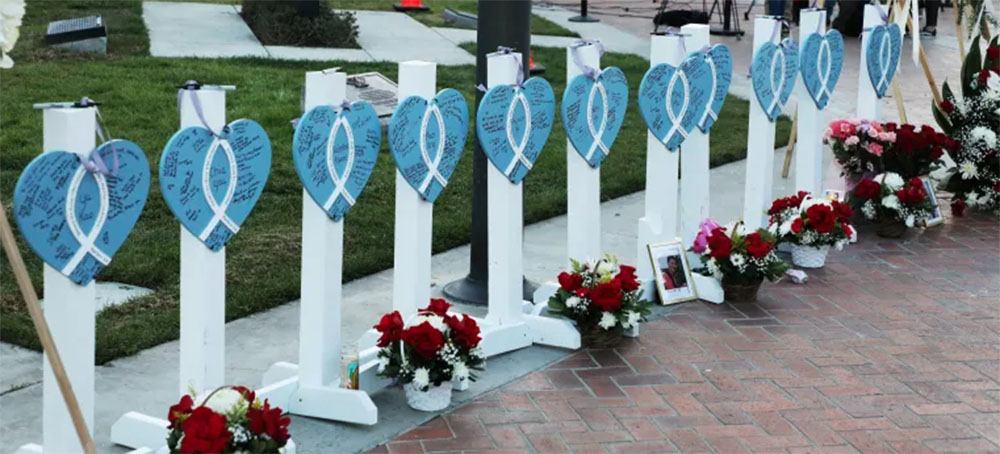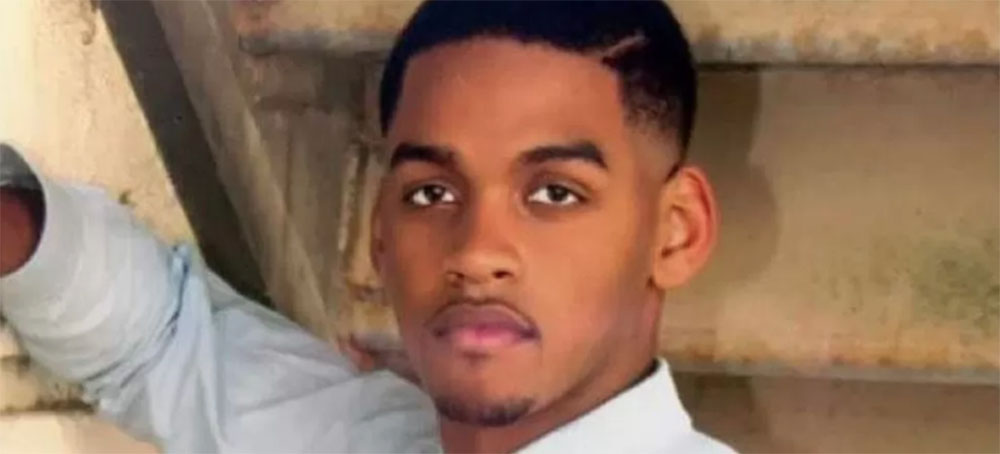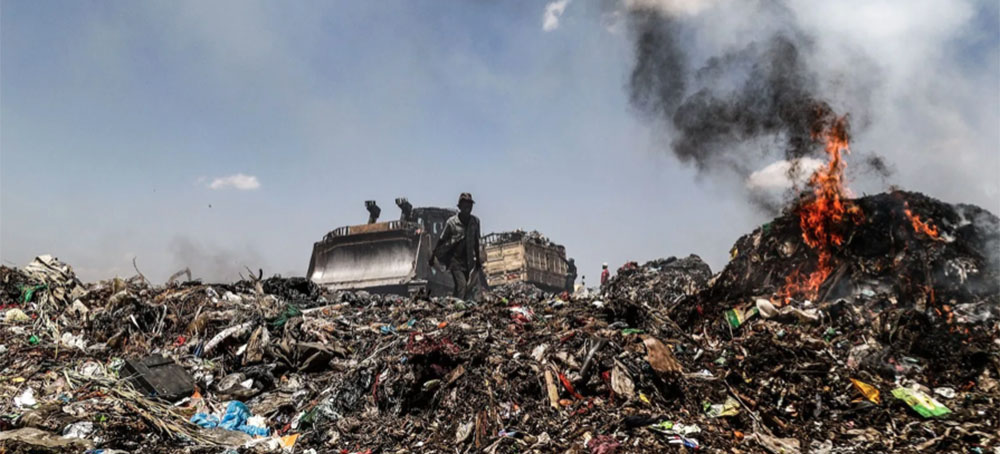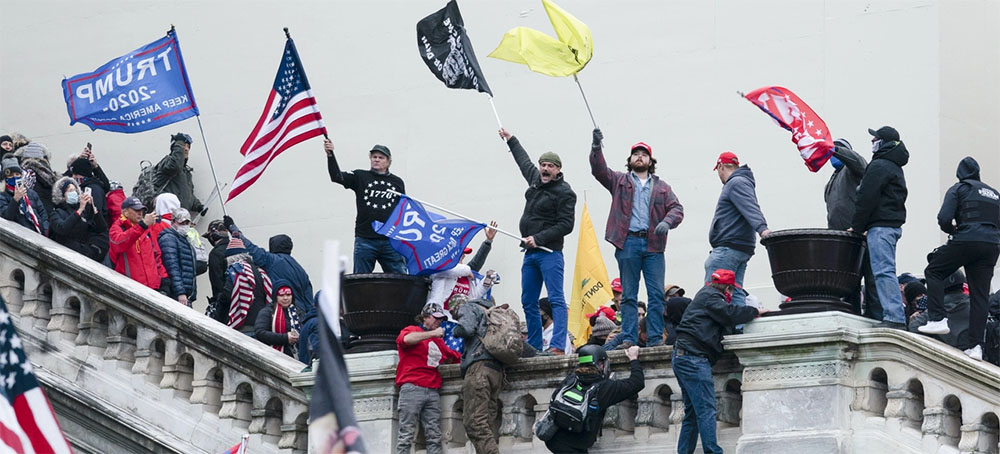UNDER CONSTRUCTION - MOVED TO MIDDLEBORO REVIEW AND SO ON https://middlebororeviewandsoon.blogspot.com/
Wednesday, March 15, 2023
POLITICO NIGHTLY: Is the recession here? Three things to watch after the SVB debacle
|
|
Silicon Valley Bank
In America today, if you're a wealthy vulture capitalist with over $250,000 in uninsured deposits at a loosely-regulated bank, the federal government will guarantee that your money is safe in a weekend.
If you’re a struggling working person with no health insurance and get cancer, you're on your own.
That’s what Martin Luther King Jr. would call "socialism for the rich and rugged individualism for the poor."
It outrages me to watch wealthy bankers and their lobbyists repeatedly endanger the American economy, fight common-sense efforts to regulate them, and then expect the government to bail them out when they create a crisis.
Five years ago, I helped lead the effort — sadly, an unsuccessful effort — to stop a bank deregulation bill that President Trump signed. That bill played a role in the collapse of Silicon Valley Bank and Signature Bank.
Now is the time to repeal that bill, break up too-big-to-fail banks and address the needs of working families, not vulture capitalists.
The good news is that the legislation which was introduced in the Senate yesterday would restore much-needed regulations on some of the largest banks in America. It will also demand that we claw back the bonuses and excessive pay from these failed bank executives.
So today, I am asking you to help send a powerful message that together we have the courage to stand up to Wall Street and vulture capitalism and repeal the disastrous 2018 bank deregulation law.
Please sign my petition:
Are our memories so short that we have learned nothing from the 2008 Wall Street crash?
Just 15 years ago, as a result of the greed and recklessness on Wall Street, this country was plunged into the worst economic crisis since the Great Depression.
As a result of the illegal behavior of Wall Street, American households lost over $13 trillion in savings, which shattered retirement dreams, wiped out life savings, and made it impossible for families to send their kids to college.
That is what Wall Street did 15 years ago.
Now, we've seen vulture capitalists at it again with the collapse of Silicon Valley Bank and Signature Bank.
How pathetic is that?
When the bank deregulation bill was up for debate in 2018, the Congressional Budget Office released a report finding that the legislation would "increase the likelihood that a large financial firm with assets of between $100 billion and $250 billion would fail."
Unfortunately, that is exactly what has happened. That's why today is an important day to show that you support repealing that disastrous legislation.
Please sign my petition:
Thank you for adding your name to my petition to call on the Senate to restore important regulations of some of the largest banks in America.
In solidarity,
Bernie Sanders

Paid for by Friends of Bernie Sanders
![]()
PO BOX 391, Burlington, VT 05402
Bannon fixer behind Hunter pics indicted ****WISCONSIN APRIL 4TH! ELECT JUDGE JANET PROTASIEWICZ ****
BREAKING NEWS
Steve Bannon’s go-to funder Guo Wengui just got indicted for fraud
The Chinese billionaire who fled to the US after being accused of major fraud, became one of the top funders of Steve Bannon, and published the hacked Hunter Biden photos, has now been indicted on 12 counts of felony … [more]

Imagine a GOP-controlled Wisconsin Supreme Court handing the 2024 presidential election to Donald Trump
WisDems: That nightmare could very well come true if we don't elect Judge Janet Protasiewicz on April 4th! Can you chip in to flip the Wisconsin state Supreme Court and keep our democracy safe from radical MAGA judges?

Tucker Carlson caught committing a fatal mistake
No Lie with Brian Tyler Cohen Red-handed.
🚨 Brian Tyler Cohen launched a Spanish YouTube channel! The left has a huge problem reaching Spanish speaking audiences, and our vote share among Spanish speakers is actually declining, so please spread the Democrats' message by subscribing to his channel (and watch some videos to get them going in the algorithm) by clicking here.
PS — Please consider a small monthly contribution of as little as $5 to help us elect Democrats and fight back against the Trump-Republican agenda. We can't do it without you. Keep fighting the good fight!
@advocacy | 1002 Hull St., Louisville, KY 40204
James Risen | Pentagon Analyst Kept Intel Job After Joining Jan. 6 Mob, Planned to Kidnap Jewish Leaders
Live on the homepage now!
Reader Supported News
Hatchet Speed built a career as a Beltway contractor and Navy reservist while praising Putin and Hitler.
At first, the new engineer, Richard Ngo, got along well with Speed. They sometimes went out to lunch together and socialized away from the office. “Speed was my mentor at Novetta as the software lead,” Ngo later said in court testimony. “We worked together every day.”
But after the insurrection at the U.S. Capitol on January 6, 2021, Ngo noticed that Speed, a longtime Navy reservist who had deployed to Iraq and Afghanistan as an intelligence analyst and held other sensitive cyber and intelligence posts in connection with Naval Special Warfare units, seemed to be changing. Ngo had always known that Speed was a gun enthusiast, but after the Capitol riot, he became more openly anti-government than he had ever been before. “He was just frustrated with just how everything was going,” Ngo testified, adding that Speed was “panic-buying” guns.
What Ngo didn’t realize was that Speed, who had legally changed his first name from Daniel to Hatchet in 2007, according to Utah court records, had been an apocalyptic far-right extremist long before January 6.
In fact, Hatchet Speed was a self-described member of the Proud Boys working deep inside the U.S. intelligence community. He joined other Proud Boys members to storm the Capitol on January 6, but he got away undetected and continued to work in sensitive jobs in the months after the insurrection, even as he amassed a huge arsenal of weapons and began to think about kidnapping Jewish leaders and others he considered an existential threat. He wasn’t arrested until 18 months after the insurrection, and no investigation has been conducted to determine whether he compromised classified information, a Navy spokesperson said. Officials at the Office of the Director of National Intelligence declined to comment on any possible damage to U.S. intelligence resulting from Speed’s decadeslong access to classified information.
A spokesperson for Accenture Federal Services, which now owns Speed’s former employer, Novetta, and which has classified contracts with the Defense Department and the intelligence community, including U.S. Cyber Command, did not respond to requests for comment.
Finally, more than a year after the Capitol riot, the FBI launched an investigation of Speed. The Bureau of Alcohol, Tobacco, Firearms, and Explosives was also involved, which suggests that records of Speed’s massive weapons purchases and his efforts to acquire unregistered silencers in the immediate aftermath of January 6 may have prompted the inquiry. In February 2022, an undercover FBI agent posing as a like-minded, right-wing gun enthusiast began meeting with Speed. That March, the Navy, aware of the FBI investigation, removed Speed’s access to sensitive Navy facilities and gave him what amounted to a fake job with Naval Warfare Space Field Activity at the National Reconnaissance Office, the agency that develops America’s spy satellites. Speed, who previously held a Top Secret/Sensitive Compartmented Information clearance, was not given access to NRO’s buildings nor its systems, a spokesperson for the NRO said. In addition to the FBI probe, Speed was also under investigation for two personnel-related cases within the Navy, a spokesperson said.
Speed was thus kept away from sensitive work while the FBI investigation was underway, until his arrest in June 2022. Yet Speed’s participation in the January 6 assault on the Capitol, and his ability to avoid detection for so long despite a series of red flags, are part of a disturbing pattern. Three active-duty Marines were given new intelligence assignments even after they were involved in the January 6 mob, The Intercept reported in February, including one who was reassigned to work inside the headquarters of the National Security Agency at Fort Meade, Maryland. The three Marines were finally arrested two years after they stormed the Capitol.
Speed, 41, has been convicted in two separate trials on charges stemming from his extremism. In January, a federal jury in Virginia found him guilty on weapons charges for illegally purchasing three silencers as part of a $50,000 weapons-buying spree in the months after January 6. And last week, in a bench trial in federal court in Washington, Judge Trevor McFadden found Speed guilty of charges stemming from his activities on January 6. He will be sentenced later this spring.
In a brief phone interview, Speed’s father, Thaddeus Speed, defended him, saying: “He’s always been a very reasonable fellow.” He declined to comment further on his son’s activities or the court rulings.
Speed’s case is significant because he is the longest-serving official in the intelligence community to be charged so far in connection with January 6. A Navy reservist for more than 20 years, with a bachelor’s degree in applied physics with an emphasis in computer science from Brigham Young University, Speed served as a cryptologic technician and intelligence analyst in the Navy reserves. He deployed to Iraq in 2009 and Afghanistan in 2011, and held other sensitive cyber and intelligence posts in connection with Naval Special Warfare units, which include the Navy SEALs. His last role before being sent to the dead-end position at the NRO was with the Naval Information Warfare Systems Command, where he was assigned in October 2021. Prior to that, he had been assigned to the Naval Criminal Investigative Service headquarters in Washington. The Navy says that Speed was cut off from access to classified information beginning in August 2021, when he was unable to perform his duties because he had refused to comply with the U.S. military’s Covid-19 vaccination mandate. His enlistment contract expired in November 2022, and he is now being processed out of the Navy reserves, according to a Navy spokesperson. In a public statement, the Navy said that it “does not and will not tolerate supremacist or extremist conduct.”
Meanwhile, Speed’s job at Novetta placed him in the northern Virginia hub of the U.S. intelligence community; when Speed worked there, the company had offices near the headquarters of the Central Intelligence Agency, the Office of the Director of National Intelligence, the National Counterterrorism Center, the NRO, and the Pentagon. When it acquired Novetta in 2021, Accenture described it as a firm that “applies disruptive technologies including artificial intelligence, machine learning, cyber, cloud and information exploitation to transform how defense, intelligence and law enforcement organizations use data to better meet their missions.”
Speed’s ability to build a career in the intelligence community while aligning himself with the Proud Boys raises questions about whether military and intelligence officials are continuing to turn a blind eye to far-right extremism in their ranks, despite Pentagon orders to root it out.
Speed joined with “100 of us Proud Boys” at a pro-Trump rally in Washington in November 2020 to protest the outcome of the presidential election, he told the undercover FBI agent. On January 6, he went to the Capitol with other Proud Boys, noting that doing so “was always the plan,” but he only decided to enter the building when he heard from others outside that Vice President Mike Pence was certifying Joe Biden’s election, which Speed saw as a betrayal. “It was like, I’m going in there,” he told the undercover agent, according to court records. “Like, I have no respect for people in this building. They have no respect for me, I have no respect for them.” Proud Boys leader Enrique Tarrio and four other top members of the group have been charged with seditious conspiracy and are currently on trial in Washington.
Speed met eight times with the FBI undercover agent, who secretly recorded their conversations. Beginning at a Starbucks near his home in Vienna, Virginia, in February 2022, Speed expressed such virulently antisemitic, racist, and genocidal views that it is difficult to understand how he could have remained in the intelligence community for so long without drawing more scrutiny. Speed expressed admiration for Adolf Hitler and Vladimir Putin, even after Putin invaded Ukraine. He told the FBI agent that he “would love to see [Putin] just really be the leader that the world needs right now,” but that might not happen because “he has a lot of Jews around him who advise him,” according to court records.
Speed spoke forthrightly about his belief that violence would be required to retake America from the control of Jews and liberals. He told the FBI agent that he wanted to kidnap Jewish leaders, including billionaire philanthropist George Soros and leaders of the Anti-Defamation League, who he blamed for creating the Black Lives Matter movement. During one conversation, Speed said, “Jews for some reason love gang raping people. It doesn’t matter what they are doing, they always have time to gang rape … white girls.” He described Hitler as “one of the best people that’s ever been on this earth,” according to court documents, adding that he wanted “somebody like Hitler to stand up and say we’re going to stand against this moral incineration.”
“I’m looking for people who are willing to say how do we do something more than just complaining on Telegram, which I’m guilty of. I scroll through Telegram way too much. But you know, what do we do in the real world to make something really happen?” Speed asked the undercover agent at one point.
The leaders of the Anti-Defamation League drew Speed’s ire because “they spend all their time pushing for laws like this anti-lynching law that Biden just signed,” he said. The ADL was pushing anti-lynching legislation because “they know things are going to get bad enough that people like us are going to band together and straight up start lynching people.”
When it came to choosing kidnapping targets, Speed told the undercover agent, he planned to go after “people that are actually reachable by someone like me. People who don’t have bodyguards.”
At about the same time he began meeting with the undercover agent in early 2022, Speed quit his job at Novetta. He had always thought of himself as a good patriot because he worked for the government, he told the undercover agent, but he no longer saw it that way and had come to believe that he was “lending his skill set to evil.” In March 2022, Speed admitted to the undercover agent that he had gone to the Capitol on January 6 with other Proud Boys and then entered the building, making it to the Rotunda.
But the intense undercover investigation by the FBI — during which Speed revealed his apocalyptic views, his willingness to engage in antisemitic carnage, and his ties to the Proud Boys — did not lead to expansive charges against him. The weapons case in Virginia was limited to straightforward charges related to his purchase of unregistered silencers; the January 6 charges were similar to those brought against many other rank-and-file intruders in the Capitol attack. He was found guilty of felony and misdemeanor charges including obstruction of an official proceeding; entering and remaining in a restricted building; disorderly and disruptive conduct in a restricted building; disorderly conduct in a Capitol building; and parading, demonstrating, or picketing in a Capitol building. The fact that the government gathered so much evidence of Speed’s interest in becoming a domestic terrorist but then only brought relatively modest charges against him contrasts starkly with the much more aggressive prosecutions faced by Muslim American defendants caught up in similar undercover operations in counterterrorism cases brought in the years after September 11.
But perhaps the greatest irony in Speed’s case came during the trial on the January 6 charges. In the case in the U.S. District Court for the District of Columbia, Speed was represented by public defenders: two Black women.
READ MORE  Su-27 fighter jets perform during an air show in St. Petersburg in 2013. (photo: Anatoly Maltsev/EPA-EFE/Shutterstock)
Su-27 fighter jets perform during an air show in St. Petersburg in 2013. (photo: Anatoly Maltsev/EPA-EFE/Shutterstock)
The incident, occurring around 7 a.m. local time, left Air Force personnel remotely operating the MQ-9 Reaper with no choice but to crash the aircraft in international waters, U.S. officials said. They characterized the encounter as part of a “pattern of dangerous actions by Russian pilots” while interacting with American and allied aircraft in international airspace, and warned that such provocations could lead to “miscalculation and unintended escalation” between the two powers.
Russia denied responsibility and faulted the American side for breaching what it called a “temporary” boundary.
The confrontation underscored the high-stakes risks of the conflict. While arming Kyiv and providing its battlefield efforts with regular overhead intelligence, the United States and NATO say they have no direct involvement in what Moscow has characterized as a Western attempt to destroy Russia.
In addition to drone surveillance and satellites, NATO flies combat air patrols and early-warning radar planes just outside Ukrainian territory in NATO and international airspace. Russian warplanes generally stay out of the air over Ukraine but regularly fly over the Black Sea, where U.S. officials say noncontact “interceptions” with Western aircraft are common.
“Our MQ-9 aircraft was conducting routine operations in international airspace when it was intercepted and hit by a Russian aircraft, resulting in a crash and complete loss of the MQ-9,” said Gen. James B. Hecker, a senior military official overseeing Air Force operations in the region. “In fact, this unsafe and unprofessional act by the Russians nearly caused both aircraft to crash.”
A Pentagon spokesman, Air Force Brig. Gen. Patrick Ryder, told reporters that the two Russian Su-27s were first seen in the vicinity of the MQ-9 about 30 to 40 minutes before American pilots brought it down. He declined to say whether the drone was armed, what its mission was or where in the Black Sea it splashed down. Video of the incident recorded by the MQ-9 must go through a declassification process before officials determine whether to release it publicly, he said. It’s unclear how long that will take.
Ryder declined to detail other similar incidents that match the pattern of dangerous activity U.S. military officials described.
In a statement, the Russian Defense Ministry claimed that, “as a result of sharp maneuvering,” the drone was observed by Russian pilots in “uncontrolled flight” before losing altitude and crashing into the sea. Jets were scrambled, officials said, when the American aircraft was detected flying “in the direction of the state border of the Russian Federation” with its transponders turned off, what they characterized as a violation of “temporary” boundaries established by Moscow for its “special military operation” in Ukraine.
“The Russian fighters did not use airborne weapons, did not come into contact with the unmanned aerial vehicle and returned safely to their base airfield,” the statement said.
Ryder rejected Moscow’s depiction of the encounter, saying the Russian jet “essentially ran into the MQ-9” and, as a result, probably suffered damage, too.
A State Department spokesman, Ned Price, told reporters that senior U.S. officials intended to communicate “our strong objections.”
“We are summoning the Russian ambassador to the department, where we will convey this message,” Price said, adding that, in Moscow, the U.S. ambassador to Russia, Lynne M. Tracy, had relayed the Biden administration’s dissatisfaction to the Ministry of Foreign Affairs.
Russian Ambassador to the United States Anatoly Antonov said in a statement to The Washington Post on Tuesday night that he was invited to the State Department and “categorically rejected all the insinuations of the US side.”
The ambassador said that the MQ-9 “was moving deliberately and provocatively towards the Russian territory with its transponders turned off [and] violated the boundaries of the temporary airspace regime established for the special military operation, which was communicated to all the concerned users of international airspace in accordance with international norms.”
Antonov added that the U.S. military’s actions are “unacceptable” that close to Russian borders.
“We are well aware of the missions such reconnaissance and strike drones are used for,” he said.
The flare-up between Washington and Moscow comes as national polling indicates some slippage in what has been broad support for the Biden administration’s campaign to provide U.S. arms and other assistance to Ukraine. Although leaders of both political parties in Congress continue to back funding Kyiv’s resistance, one leading presidential candidate, Donald Trump, and another top Republican, Florida Gov. Ron DeSantis, have declared that backing Ukraine in the war against Russia is not in the United States’ strategic interests.
In a clear sign of the GOP’s split over the war, Sen. Roger Wicker (Miss.), the Senate Armed Services Committee’s top Republican, issued a statement criticizing those who would seek to “appease” Russian President Vladimir Putin. “This incident,” Wicker said, “should serve as a wake-up call to isolationists in the United States that it is in our national interest to treat Putin as the threat he truly is.”
In the House, the Armed Services Committee chairman, Rep. Mike D. Rogers (R-Ala.), struck a similar tone, saying in a statement circulated on Twitter that “Putin … his cronies are attempting to test our resolve — a test that we cannot afford to fail.”
A leading critic of President Biden’s aid program, Rep. Matt Gaetz (R-Fla.), lamented, however, what he called the “treacherous reality” of American support for the war and his fear that the U.S. military will become more deeply entangled in the fighting. He called on Biden “to end our involvement in this war before the counting of lost dollars in this conflict becomes the counting of dead Americans in Ukraine.”
White House spokesman John Kirby said Biden was briefed about the incident Tuesday morning by national security adviser Jake Sullivan. While intercepts of aircraft happen with some frequency, Kirby said, “this one, obviously, is noteworthy because of how unsafe [and] indeed reckless” the Su-27s were “in causing the downing of one of our aircraft.”
The U.S. and Russian militaries set up years ago a phone line for the “deconfliction” of air operations to avoid collisions and other incidents that could prompt a crisis. Kirby said that the Black Sea is “an enormous body of water” and that U.S. aircraft have been flying in international airspace there “consistently” for a year.
“We’re going to continue to do that,” Kirby said. “And we don’t need to have some sort of check-in with the Russians before we fly in international airspace.”
No wreckage from the crash site had been recovered by Tuesday evening, and it was unclear whether the United States would be able to do so. No American military vessel has been in the Black Sea since Russia renewed its invasion of Ukraine more than a year ago, according to USNI News, an independent news site that tracks U.S. naval movements.
A defense official, speaking on the condition of anonymity because the matter is highly sensitive, agreed that it would be exceedingly difficult for the Pentagon to salvage the drone. Russia has mined portions of the Black Sea in the past, Ukrainian officials have said, notably around Crimea.
Russia’s Su-27 Flanker has been in service since the 1980s, and is similar in size and capabilities to the American F-15 fighter jet. Before Russia sent tens of thousands of troops into Ukraine last year, Su-27s were used to intercept a variety of other American aircraft near Crimea, including a 2018 incident the Pentagon deemed unsafe involving a Navy E-P3 electronic signals surveillance plane.
The Reaper, made by General Atomics, has conducted surveillance and strike missions over Iraq, Afghanistan, Syria and beyond. Ukrainian officials have expressed interest in obtaining some from the United States, but the Biden administration has rejected the idea, citing the danger posed by Russian air defenses, concerns about the technology aboard falling into Russian hands and the length of time it would take to train Ukrainian pilots.
In January, General Atomics offered to provide Ukraine with two Reapers for a dollar, with the caveat that the government in Kyiv would need to find $10 million to cover the costs of preparing and shipping the aircraft and another $8 million per year to cover regular maintenance. The Biden administration would have approval authority over any deal and has opted instead to send smaller one-way attack drones.
Philip Breedlove, a retired Air Force general and former supreme allied commander of NATO, said Tuesday that such actions by the Russians are not new, and he wouldn’t rule out that the incident was born from a “stupid mistake.”
“This could be as simple as poor airmanship, poor professionalism,” he said.
If the collision was deliberate, though — which Breedlove emphasized there’s no evidence of so far — then it is significant and indicates that “Russia is trying to change the narrative” by striking a blow on the United States. “That would be concerning,” he added. “That they are so desperate to send that message that they actually strike something American.”
READ MORE  Women cover their eyes in reference to the protesters being blinded by rubber bullets and tear gas, during an antigovernment protest in Chile. (photo: Edgard Garrido/Reuters)
Women cover their eyes in reference to the protesters being blinded by rubber bullets and tear gas, during an antigovernment protest in Chile. (photo: Edgard Garrido/Reuters)
Rights group says a global Torture-Free Trade treaty is urgently needed to regulate the trade in policing equipment.
The human rights group, in a new report published on Tuesday, said a global Torture-Free Trade treaty was needed to regulate the trade in policing equipment, including kinetic impact projectiles (KIPs) such as rubber-coated metal bullets, and to help protect the right to protest.
“We believe that legally-binding global controls on the manufacture and trade in less lethal weapons, including KIPs, along with effective guidelines on the use of force are urgently needed to combat an escalating cycle of abuses,” said Patrick Wilcken, Amnesty International’s researcher on military, security and policing issues.
Police misuse of such weapons, in addition to causing deaths, has resulted in an “alarming increase in eye injuries”, said the report, published jointly with the Omega Research Foundation and titled “My Eye Exploded”.
These injuries include eyeball ruptures, retinal detachments and the complete loss of sight, as well as bone and skull fractures, brain injuries, the rupture of internal organs and haemorrhaging, punctured hearts and lungs from broken ribs, damage to genitalia and psychological trauma.
For instance, in Chile, an evaluation by the country’s National Institute for Human Rights found that police actions during antigovernment protests in 2019 resulted in more than 440 eye injuries, with more than 30 cases of eye loss.
Among them was Gustavo Gatica, a 22-year-old psychology student, who was blinded in both eyes after being hit in the face by rubber-coated metal pellets fired by police during a protest on November 8, 2019.
“I felt the water running from my eyes … but it was blood,” Gatica told Amnesty. He said he hoped his injuries would inspire change and stop the same from happening to others.
“I gave up my eyes so people would wake up,” he said.
Amnesty said the use of rubber bullets to suppress peaceful protest has also become commonplace in the United States.
One demonstrator hit in the face in Minneapolis, Minnesota, on May 31, 2020, said his “eye exploded” from the impact of the rubber bullet, and his nose moved from where it should be to below the other eye.
The demonstrator, who underwent reconstructive surgery, added, “They put in a prosthetic eye — so I can only see out of my right eye now.”
In Palestine, Amnesty said Israeli forces have continued to routinely use rubber-coated metal bullets against Palestinians despite Israel’s Supreme Court recommending in 2000 that such weapons were lethal and should not be used for policing demonstrations.
A recent report by the United Nations Human Rights Council documented 438 injuries among Palestinians due to Israel’s use of rubber-coated metal bullets during the Great March of Return protests of 2018.
Amnesty said it has also documented “widespread unlawful use of metal pellets” by Iran’s security forces against protesters across the country, resulting in multiple deaths and thousands of injuries.
The deaths included 19 people killed by security forces firing metal pellets during the protests that swept the country following the custodial death of 22-year-old Mahsa Amini last year.
Amnesty said it has also documented the use of tear gas grenades being aimed and fired directly at individuals or crowds in Chile, Colombia, Ecuador, France, Gaza, Guinea, Hong Kong, Iran, Iraq, Peru, Sudan, Tunisia and Venezuela.
In Iraq, security forces in 2019 deliberately targeted protesters with grenades that are 10 times heavier than typical tear gas munitions, causing “horrific injuries and at least two dozen deaths”, it said.
But despite the grave risks in the deployment of rubber bullets and other less lethal weapons, there are currently no international regulations on the manufacture and trade of this equipment.
Amnesty and the Omega Research Foundation said that human rights-based trade controls needed to be introduced on the supply of such weaponry as part of a UN-backed agreement.
“A Torture-Free Trade Treaty would prohibit all production and trade in existing inherently abusive law enforcement weapons and equipment, including intrinsically dangerous or inaccurate single KIPs, rubber-coated metal bullets, rubberized buckshot and ammunition with multiple projectiles that have resulted in blinding, other serious injuries and deaths across the world,” said Michael Crowley, research associate at the Omega Research Foundation.
READ MORE Greenpeace USA activists project a message reading “Protect The Oceans" onto the United Nations headquarters in New York on March 3, 2023. (photo: Greenpeace)
Greenpeace USA activists project a message reading “Protect The Oceans" onto the United Nations headquarters in New York on March 3, 2023. (photo: Greenpeace)
The accord reached by the Intergovernmental Conference on Marine Biodiversity of Areas Beyond National Jurisdiction establishes a mechanism for sharing the benefits of scientific discoveries from marine life, enforces environmental impact assessments for new human activities in international waters and makes it possible to create protected areas in the open ocean.
“It’s going to provide first-time protections ever for half of the planet that has not ever had that,” Greenpeace USA senior oceans campaigner Arlo Hemphill told EcoWatch in an email. “And that makes it the largest conservation agreement in the history of the world.”
It’s also not one that was reached easily. The final agreement is the work of more than a decade of formal negotiations and two decades of political mobilization. Hemphill spoke with EcoWatch about why it took so long and what finally eased its passage through the rough waters of international discord.
Running Aground
When the idea of a high seas treaty was first broached two decades ago, protecting international biodiversity was not on the radar of world leaders. There was also a significant amount of resistance from the fishing industry.
“Just the very idea of this was a threat to global fishery corporations,” Hemphill said.
However, as negotiations first began and then stalled, one key issue emerged as the sticking point: how to share the benefits of Marine Genetic Resources (MGRs), or any new medicines, foods, textiles or other innovations derived from lifeforms discovered in international waters. Countries from the Global South were justifiably concerned that wealthy corporations and countries in the Global North would be the only ones to profit from such discoveries.
The question, Hemphill explained, was “how we’re going to implement something that is considered the common heritage of humankind, meaning it belongs to every person, in a way that was equitable to the 85 percent of the planet that doesn’t have the resources to be out there studying things.”
That said, the Global North was concerned that a true profit-sharing agreement would generate so much bureaucracy that companies would be disincentivized to do any research. Further, it could take 10 to 15 years before any research actually led to a product that could make money.
The breakthrough came with a proposal from the Global North to offer money from any potential discoveries up front to fund the implementation of the treaty, help poorer nations establish marine sanctuaries and pay for their delegates to attend future meetings.
‘The Ship Has Reached the Shore’
The Global North first offered a payment package at the end of negotiations in August of 2022, but it did so at the last minute.
“Countries did not have the bandwidth to take the proposal back to their capitals and get an answer by the end of the week,” Hemphill said.
That money was on the table when negotiations began again on Feb. 20 of 2023, but still, during the second and last week of negotiations, it looked like countries might fail to reach a deal.
“The future of half our planet is at stake and yet negotiations have been progressing at a snail’s pace, and this is reflected in the new draft Treaty text,” Greenpeace’s Co-Executive Director Will McCallum told EcoWatch in an email Feb. 28. “With major setbacks impacting its ability to create marine protected areas in our global oceans and Global North countries like the UK, U.S. and European Union member states refusing to seek compromises on other areas we need to see a step change in pace in the coming three days.”
What made that change possible, according to Hemphill’s account, was the leadership of Conference President Rena Lee of Singapore, who held one-on-one meetings with the most stubborn national delegations.
“She basically brought these people one by one in meetings that were happening around the clock all through Friday night, all into Saturday,” he said.
By 9:30 p.m. on Saturday, she said that there was an agreement with enough votes to pass.
“Ladies and gentlemen, the ship has reached the shore,” she announced Saturday night on UN Web TV.
The U.S. Changes Tack
Another factor that helped ease negotiations was the role of the U.S., which was an obstacle to progress under former Presidents Donald Trump and even Barack Obama, but emerged as a leader under the administration of current President Joe Biden.
“I thought the U.S., which was really a terrible player in this, really came through at the end and brought things through in a really special way that made me proud to be an American citizen for once,” Hemphill said.
Hemphill singled out Assistant Secretary of State for Oceans and International Environmental and Scientific Affairs Monica Medina, who had made it a priority to see a treaty negotiated during her tenure and saw it through to the bitter end. Hemphill saw her sleeping on a couch outside the conference room at 3 a.m. during the last days of negotiations. Medina herself applauded the outcome of the negotiations.
“Today the world came together to protect the ocean for the benefit of our children and grandchildren. We leave here with the ability to create protected areas in the high seas and achieve the ambitious goal of conserving 30 percent of the ocean by 2030,” Medina said in a statement on Twitter. “And the time to start is now.”
30 by 30
Another factor that helped clinch Saturday’s agreement was the fact that the world had already agreed to protect 30 percent of land and waters by 2030 during the COP15 UN Biodiversity Conference in Montreal in December of 2022.
“It totally changed the tone,” Hemphill said.
During previous negotiations, countries that opposed the 30 by 30 target could point to a lack of agreement on the goal to oppose conservation measures.
“If we had not gotten the 30 by 30 agreement in Montreal, we would have been in a very weak position coming in here,” Hemphill said.
The target and the treaty have a sort of symbiotic relationship, because negotiators were also aware it would be difficult for their nations to meet their 30 by 30 commitments without a robust agreement.
‘If this treaty had not been agreed upon, it would have just literally been impossible to get to 30 percent without being able to create sanctuaries in international waters,” Hemphill said.
All Hands on Deck
Bolstering the more ambitious negotiators were the voices of concerned ocean lovers and activist groups like Greenpeace that had organized for a successful treaty.
As a member of the High Seas Alliance, Greenpeace both lobbied government negotiators and mobilized the public through a “Protect the Oceans” ship tour researching and highlighting ocean places in need of protection, days of action bringing ocean imagery to major cities and a petition that garnered nearly six million signatures. During the last round of negotiations, Greenpeace members staged an art occupation of beach plastic marine animals and chalk seascapes outside the UN.
“WE DID IT!” actor and activist Jane Fonda, who participated in a Greenpeace press briefing ahead of the most recent negotiations, tweeted when the deal was announced. “Yesterday, on March 4th, 2023, after years of talks, delay and emotional rollercoaster, governments finally concluded a Global Ocean Treaty!!! I am so grateful for everyone, including @Greenpeace, who helped to make this historic win possible.”
Sailing On
Environmental groups like Greenpeace do not plan to rest in the harbor just because negotiations have wrapped. The treaty now has to be ratified by at least 60 member states, and the next goal of activists is to push for the protection of particular high seas ecosystems. One promising candidate is the Sargasso Sea, since the governments of Bermuda, the U.S., Canada, the UK and other Caribbean nations are already in talks to protect it.
As part of its Protect the Oceans tour, Greenpeace took University of Florida scientists to the sea to test the hypothesis that the mats of sargassum algae that give it its name could act as an incubator for baby sea turtles.
“We went around and took measurements inside and outside the sargassum mats and found very distinct and consistent temperature differences that are most likely helping accelerate the growth of baby sea turtles so they can get beyond that fragile stage,” Hemphill said.
Other candidates for protection include the Costa Rica Dome, the Emperor Seamounts in the North Pacific and Walvis Ridge off the coast of Namibia.
Another pressing ocean issue that the treaty might help with is deep-sea mining. It won’t be in place in time to do anything about the fact that the two-year rule has been triggered, which means the UN’s International Seabed Authority has to either establish new regulations or allow mining to proceed under existing rules by July of this year. However, in the future it may be able to mitigate the impacts of extracting minerals from the seabed.
“Theoretically, deep sea mining should be under a higher standard of environmental impact assessments after this treaty, and there would be the capacity to build ocean sanctuaries… in places that are already of interest to deep sea miners,” Hemphill said.
READ MORE  US President Joe Biden has called for more stringent gun regulations to help prevent mass shootings, such as the one that occurred in Monterey Park, California, in January. (photo: David Swanson/Reuters)
US President Joe Biden has called for more stringent gun regulations to help prevent mass shootings, such as the one that occurred in Monterey Park, California, in January. (photo: David Swanson/Reuters)
Executive order to expand firearm background checks signed amid ongoing challenge of passing stricter US gun laws.
Biden underscored his commitment to further regulate guns in an announcement on Tuesday before a visit to the California community of Monterey Park, where a gunman stormed a dance hall and killed 11 people in January.
“We remember and mourn today, but I’m here with you today to act,” said Biden. “This executive order helps keeps firearms out of dangerous hands as I continue to call on Congress to require background checks for all firearms sales.”
The executive order aims to expand background checks and increase public awareness of so-called “red flag laws”, which are meant to keep guns out of the hands of people displaying troubling behaviour that is reported to law enforcement by family or friends.
It also calls for the Federal Trade Commission to investigate the methods gun manufacturers use to market firearms to minors and civilians, including the use of military imagery in their campaigns.
Biden’s order builds on previous legislation the president signed in June that included similar measures and a provision barring those convicted of domestic violence from purchasing firearms if they are still involved with the victim.
The announcement on Tuesday called last year’s law — which followed a shooting at an elementary school in Uvalde, Texas, in which 19 children and two staff members were killed — “the most significant gun violence reduction legislation enacted in nearly 30 years”.
However, some observers have pointed out that the legislation did little to substantially decrease firearms access in the US.
It also did not include restrictions on assault-style rifles that have been used in numerous mass shootings, which Biden has said he would like to see banned.
“Let’s be clear: None of this absolves Congress from the responsibility of acting to pass universal background checks, eliminate gun manufacturing immunity from liability,” Biden said in his speech on Tuesday. “And I am determined, once again, to ban assault weapons and high capacity magazines.”
A Reuters/Ipsos poll last year found 84 percent of respondents supported background checks for all firearms sales and 70 percent backed red flag laws.
Some gun rights advocates oppose background checks, saying they infringe on the constitutional right to possess arms while failing to stop criminals from getting them. They also contend many red flag laws trample on due process rights.
Republican legislators are largely hostile to attempts to enact more comprehensive gun control legislation, and the conservative majority in the US Supreme Court has struck down gun laws in Democrat-governed states such as New York.
The White House seemed to acknowledge those challenges on Tuesday, stating that the measures contained in Biden’s executive order would move the US “as close to universal background checks as possible without additional legislation”.
Addressing the community of Monterey Park in his closing remarks, Biden said he knew that there were some in the community whose “hearts are broken”.
“I promise you that the day will come when the memory of your loved one will bring a smile to your lips before it brings a tear to your eye,” said Biden. “I promise you, it will come.”
READ MORE  Before he disappeared, Rasheem Carter told his mother he was being chased by white men in trucks. (photo: Tiffany Carter/BBC)
Before he disappeared, Rasheem Carter told his mother he was being chased by white men in trucks. (photo: Tiffany Carter/BBC)
"Nothing is being swept under the rug," the sheriff said. "There’s nothing to hide."
Carter, 25, was found dead last fall after he warned his mother that he was being chased by white men hurling racial slurs.
In an interview with NBC News, Smith County Sheriff Joel Houston defended his early determination, saying no evidence at the time pointed to homicide. But he said his department is still waiting on search warrants to rule more definitively.
For the first time, the sheriff revealed key aspects of the investigation, including the department’s process of ruling out potential suspects.
The interview came one day after Carter’s loved ones and their attorney Ben Crump slammed authorities for stonewalling them for more than four months and accused the police of covering up what they believe was a brutal hate crime.
“Nothing is being swept under the rug,” Houston said Tuesday. “There’s nothing to hide.”
Carter was reported missing on Oct. 2, after his mother said he had sought help from police and frantically called her to say white men in three trucks were pursuing him. That was the last day Carter’s family heard from him.
On Nov. 2, authorities said they found his remains in a wooded area south of Taylorsville, Mississippi. In a statement on Facebook a day later, the Smith County Sheriff’s Department said it had “no reason to believe foul play was involved,” though the case was under investigation.
Carter's loved ones and family attorney were dismayed by that swift decision by the sheriff and urged the Justice Department to take over the investigation as a civil rights case during a news conference Monday.
"This was a nefarious act. This was an evil act,” Crump said. “Somebody murdered Rasheem Carter, and we cannot let them get away with this.”
The sheriff said Tuesday that his department initially said that no foul play was suspected to ease public concern after finding no early evidence that Carter had been chased.
"It was just letting the local or general public know that at this time no one else is believed to be involved," he said. "It does seem to have caused unnecessary headache, but we only have what the evidence tells us. At that time, the evidence didn’t suggest anything."
Carter, a welder from Fayette, Mississippi, was in Taylorsville, about 100 miles away from home, working a short-term contracting gig. His mother, Tiffany Carter, said he was saving money to reopen his seafood restaurant, which closed during the pandemic and which was named after his 7-year-old daughter, Cali.
“That was his goal,” she said. “That was why he went back out to work.”
But while he was at the job site in October, Carter had a disagreement with at least one co-worker and fled, fearing for his life, his mother said.
“He said, ‘I got these men trying to kill me,’” Carter’s mother recalled him saying.
She advised Carter to go to the nearest police station for help but eventually lost contact with him.
On Tuesday, the sheriff said his department interviewed “everybody involved” with Carter’s last job, including four to five people Carter had mentioned to his mother as possible threats.
Houston said police “ruled them out” after determining through phone records and GPS coordinates that their devices were nearly 100 miles away from Taylorsville at another job site when Carter was last seen alive.
The sheriff said Carter’s colleagues and supervisor mentioned in their interviews that Carter “had not been himself” for about a week before he went missing.
“They said his whole demeanor had changed. They weren’t sure what was going on,” Houston said. "They just said he kept to himself more. He usually joked around, and in the last week or so they weren’t able to do that.”
Houston said Carter had “a couple of verbal altercations” with at least one co-worker. But the sheriff did not say what the disagreement was about or whether the altercation prompted Carter's behavior change.
Carter was last seen captured on a private landowner’s game camera out in the woods on Oct. 2 after 4:30 p.m., Houston said, adding that he was the only person spotted in the footage.
The sheriff said the property owner passed the image along to police when he found out about it in mid-October. Houston said it took about two weeks to search several hundred acres, using cadaver dogs.
Along with Carter's scattered remains, authorities found inside his blue jeans some cash, bank cards, a driver’s license, a vape and a phone charger, though they never recovered his phone.
The sheriff's department has submitted a search warrant to Google to determine whether any devices pinged in the area where Carter's remains were found around the time he went missing.
“It’s a last-straw-type deal to determine if anyone else was with him or not,” he said. “It’s not uncommon to use this tool.”
However, the process has been going on since mid-November, Houston said, and the department has had to revise, narrow down and resubmit their request several times, including most recently last week.
Houston said that he welcomes the Justice Department's involvement and that he wants justice for Carter's family "just as much as the family does."
The Carters disagree.
Three members of the family said authorities told them wild animals may have torn his body apart.
“He was in so many different pieces,” said Yokena Anderson, a cousin to Carter’s mother. “They wanted to tell us that he went there and fell dead and the animals were feeding off him.”
Carter’s mother said that her son was lucid about the threats he faced during their final phone calls and that he was not under the influence of drugs or alcohol and had no history of mental illness.
"I just know what my son told me," she said Tuesday. "I don’t believe anything they say. It’s lies after lies."
READ MORE  Plastic waste. (photo: James Wakibia/SOPA Images/LightRocket)
Plastic waste. (photo: James Wakibia/SOPA Images/LightRocket)
Current estimates only cover “the tip of the plastic waste iceberg.”
According to a new analysis published last week, United Nations data on the global waste trade fails to account for “hidden” plastics in textiles, contaminated paper bales, and other categories, leading to a dramatic, 1.8-million-metric-ton annual underestimate of the amount of plastic that makes its way from the European Union, Japan, the United Kingdom, and the United States to poor countries. The authors highlight the public health and environmental risks that plastic exports pose in the developing world, where importers often dump or incinerate an unmanageable glut of plastic waste.
“Toxic chemicals from these plastics are poisoning communities,” said Therese Karlsson, a science and technical adviser for the nonprofit International Pollutant Elimination Network, or IPEN. IPEN helped coordinate the analysis along with an international team of researchers from Sweden, Turkey, and the U.S.
Many estimates of the scale of the plastic waste trade make use of a U.N. database that tracks different types of products through a “harmonized commodity description and coding system,” which assigns each product category a code starting with the letters HS. HS 3915 — “waste, parings, and scrap” of plastics — is often assumed by researchers and policymakers to describe the total volume of plastic that’s traded globally. But the new analysis argues this is only “the tip of the plastic waste iceberg,” since HS 3915 misses large quantities of plastic that are included in other product categories.
Discarded clothing, for example, may be tracked as HS 5505 and not counted as plastic waste, even though 60 to 70 percent of all textiles are made of some kind of plastic. And another category called HS 6309 — used clothing and accessories — is assumed by the U.N. to be reused or recycled and is therefore not considered waste at all, even though an estimated 40 percent of these exported clothes are deemed unsalvageable and end up dumped in landfills.
Plastic contamination in paper bales — the huge stacks of unsorted paper that are shipped abroad to be recycled — also tends to be overlooked in estimates of the international plastic waste trade, even though these bales may contain 5 to 30 percent plastic that must be removed and discarded.
Accounting for plastic from just these two product categories increases plastic waste exports from all the regions analyzed by as much as 1.8 million metric tons per year — 1.3 million from paper bales and half a million from textiles. That’s more than double the plastic that’s counted when only plastic “waste, parings, and scrap” are analyzed.
Additional product categories like electronics and rubber add even more to the global plastic waste trade, although Karlsson said a lack of data makes it hard to quantify their exact contribution. All this plastic strains developing countries’ waste management infrastructure, leading to large quantities of plastic waste ending up in dumps, landfills, or incinerators. Burning this waste causes hazardous air pollution for nearby communities, and dumps and landfills can leach chemicals like PCBs — a group of compounds that can cause cancer in humans — into soil and water supplies.
More than 10,000 chemicals are used in the production of plastic, and one-fourth of them have been flagged by researchers for their toxicity and potential to build up in the environment and in people’s bodies. The report calls for greater transparency from plastic and petrochemical industries about the chemicals they put in their plastic products, and for regulators to require them to use fewer, nontoxic chemicals.
Karlsson also called for a total ban on the global plastic waste trade, along with enforceable limits on the amount of plastics the world makes in the first place. “Regardless of what way we’re handling plastic waste, we need to decrease the amount of plastics that we generate,” she told Grist, “because the amount of plastic waste being produced today will never be sustainable.”
Without aggressive action to phase down plastic production, the world is on track to have produced a cumulative 26 billion metric tons of plastic waste by 2050, most of which will be incinerated, dumped, or sent to landfills.
Follow us on facebook and twitter!
PO Box 2043 / Citrus Heights, CA 95611
With a New J6 Probe, MAGA Again Shows How Bonkers It Is
LOTS OF POSTS IGNORED BY BLOGGER..... ALL POSTS ARE AVAILABLE ON MIDDLEBORO REVIEW AND SO ON YOUR FREE TRIAL HAS EXP...

-
04 April 23 Live on the homepage now! Reader Supported News Dahlia Lithwick | Let Donald Trump Cry It Out Dahlia Lithwick, Slate Lithwic...
-
A Democrat in the Wilderness Wow! That must have really got him mad!!! I Love it! ...
-
Israel on the Brink as Ultra-Orthodox Exemption from Military Service is Set to End Oakland, Ca. (Special to Informed Comment; Featured) –...









